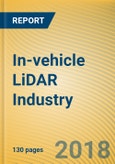Global Automotive LiDAR Sensor Market Expected to Reach USD1.4 Billion in 2022
Global automotive LiDAR sensor market was USD300 million in 2017, and is expected to reach USD1.4 billion in 2022 and soar to USD4.4 billion in 2027 in the wake of large-scale deployment of L4/5 private autonomous cars.
Being subject to autonomous driving technologies as well as laws and regulations, the autonomous driving companies has limited demand for LiDAR as yet. Mature LiDAR firms are mostly foreign ones, such as Valeo and Quanergy. Major companies that have placed LiDARs on prototype autonomous driving test cars are Velodyne, Ibeo, Luminar, Valeo and SICK.
There are four firms that have already brought or plan to bring products to the market, specifically;
- Continental SRL1: State-of-the-art LiDAR for Advanced Driver Assistance Systems, single-beam solid-state LiDAR, installed on Volvo XC60 and S60L;
- Valeo SCALA Gen.1, mechanical 4-beam LiDAR, installed on Audi A8/A7/A6;
- InnovizOne (MEMS solid-state LiDAR), will be installed on L3 autonomous car to be launched by BMW in 2021;
- Quanergy S3 (OPA LiDAR), will be installed on new luxury electric model- Emotion built by Fisker.
Chinese LiDAR companies lag behind key foreign peers in terms of time of establishment and technology. LiDARs are primarily applied to autonomous logistic vehicles (JD and Cainiao) and self-driving test cars (driverless vehicles of Beijing Union University and Moovita). Baidu launched Pandora (co-developed with Hesai Technologies), the sensor integrating LiDAR and camera, in its Apollo 2.5 hardware solution.
LiDAR will become smaller, solid-state and more cost-effective in the future. Solid-state LiDAR needs no rotating parts and hence is smaller and easily integrated in car body. Moreover, the reliability is improved and the costs can be reduced in great measure. So, the solid state of LiDAR will be an inevitable trend.
Most mainstream LiDAR vendors plan to launch solid-state radar around 2020, following technological routes of MEMS, OPA and Flash.
According to ADAS and autonomous driving plans of major OEMs, most of them will roll out SAE L3 models around 2020. Overseas OEMs: PAS SAE L3 (2020), Honda SAE L3 (2020), GM SAE L4 (2021+), Mercedes Benz SAE L3 (Mercedes Benz new-generation S in 2021), BMW SAE L3 (2021). Domestic OEMs: SAIC SAE L3 (2018-2020), FAW SAE L3 (2020), Changan SAE L3 (2020), Great Wall SAE L3 (2020), Geely SAE L3 (2020), and GAC SAE L3 (2020). The L3-and-above models with LiDAR are expected to share 10% of ADAS models in China in 2022. The figure will hit 50% in 2030.
Global and China In-vehicle LiDAR Industry Report, 2017-2022 focuses on the following:
- In-vehicle LiDAR market (status quo of application, market size forecast);
- Leading in-vehicle LiDAR companies at home and abroad (development course, profile, financing, LiDAR products, product planning & technical direction, partners, etc.);
- Trends of LiDAR Technologies and Costs.
*Note: The Chinese Version of this Report is Available on Request.
This product will be delivered within 3-5 business days.
Table of Contents
Samples

LOADING...
Companies Mentioned
- Aeye
- Blackmore
- Hesai Technologies
- Ibeo
- Innoviz
- LeddarTech
- LeiShen Intelligent System
- Luminar
- Ouster
- Quanergy
- RoboSense
- SureStar
- Valeo
- Velodyne
Methodology

LOADING...








